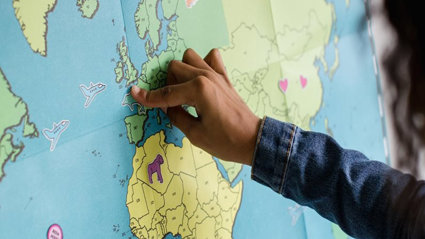
Fieldwork
This section of ‘Developing Primary Geography’ provides advice and support about planning fieldwork experiences
Why do fieldwork?
Fieldwork is the jewel in the crown of geography and should be done regularly because:
-
It engages children with real-world learning
-
It enables purposeful data collection
-
It connects children to their local environment, creates memories and helps develop identity
-
It helps explain the often ‘messy’ nature of geography in the real world, compares this to theory, and so deepens understanding
-
It promotes curiosity, vocabulary acquisition, creativity and critical thinking
-
It provides a genuine context for geographical skills and enquiry
-
It is a statutory requirement for geography
Effective fieldwork supports pupils’ motivation and enhances learning in geography. …
Where fieldwork was properly conceived, adequately planned, well taught and followed up effectively, pupils were able to develop their knowledge and skills and the work added value to their classroom experiences. However, in just over half the schools visited, opportunities for fieldwork had decreased substantially in recent years.
Ofsted (2011) par.99
What does good fieldwork look like?
Fieldwork combines knowledge with skill and requires children to think about what places are like and why, where places are and why, and how they connect to other places. Good fieldwork:
-
allows pupils to enquire about places at first-hand
-
requires pupils to use and practice a range of skills in a variety of contexts
-
builds core knowledge and a sense of place
-
has a strong spatial dimension and develops understanding of location
-
revisits and investigates the same location over time, noting change and different aspects of place
-
visits a range of places near and far and encourages children to look further and deeper
-
develops creative and critical thinking
-
builds on pupils’ own questions and ideas
-
often has purposeful outcomes.
Where should we go?
Even the humblest and ordinary looking street can provide lots of opportunities to enquire about the world. Fieldwork doesn’t have to always be about the ‘big trip’. Everyday places immediately around the school can be very productive. Seemingly mundane places ooze geography once you start to enquire and look closer.
There should be some progression and planning in fieldwork throughout the school. In Key Stage 1, children should be investigating the school grounds and the immediate locality, usually defined as an area that can be easily reached on foot. In Key Stage 2, children might explore a larger area encompassing not just the school and its surrounds but the neighbourhood where children live as well.
It is good practice to capitalise on features of interest and significance in your wider locality if you can access them. For example, you might be able to visit a nearby place of interest such as a beach or a river. If you are an urban school, you might be able to visit a rural area and vice versa. At the end of KS2, some schools provide a residential geography to a contrasting area and sometimes even an overseas locality. You can read more about the value of residential trips with primary children in the document below.
Use the form ‘Where do your pupils go for fieldwork?’ below, to audit where each year group in your school goes to and what they do there. Investigating the range of localities visited and the focus of the fieldwork can help you reflect and improve on progression in fieldwork.
Ideally, fieldwork should, although it can be done as a stand-alone activity, introduce, support and / or extend further geography study in the classroom.
How do I manage risk assessment?
Teachers need to do a risk assessment before taking pupils out on fieldwork. You can find out more about risk assessment from the Field Studies Council. However, it’s good practice to also carry out a risk assessment with pupils in the classroom before taking them out. This can be done by bringing the ‘outside in’ through images captured by Google Earth or direct exploration of the local area using Google’s Street Map or an animated map programme such as TripGeo. In this way pupils will have a chance to rehearse the visit and be more aware of potential danger.
Carrying out a risk assessment with pupils before a trip also invites a deeper participation as it involves them taking a greater degree of responsibility. This can be used to evidence aspects of Social, Moral, Spiritual and Cultural (SMSC) criteria for the school Self Evaluation Framework (SEF) for example ‘learning how to keep safe’.
For regular visits to the immediate locality it is useful to have ready laminated checklist forms and risk assessments hanging by the school entrance. Although you will of course be mindful of weekly or even day to day changes, it is unlikely that there will be significant changes.
Useful Links
-
Royal Geographical Society (with IBG) fieldwork and local learning resources- please search our resources database for fieldwork resources
File nameFiles
File type
Size
Download
